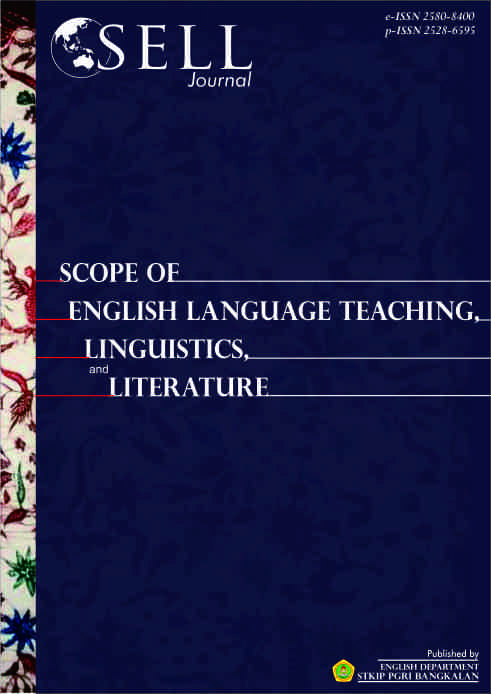The Perceptions of English Students' Reading Strategies at University Level
DOI:
https://doi.org/10.31597/sl.v6i1.590Keywords:
reading strategies, students' perception, college studentsAbstract
Reading needs an appropriate strategy to get out the point of the passage effectively. This research aimed to investigate the English students’ perceptions of their reading strategies at PGRI Wiranegara University. The purpose of this research was to describe the students’ perception about reading strategies and finding the highest and the lowest scores of reading strategies. Type of this research was descriptive quantitative research. The research subjects were English students at PGRI Wiranegara University Pasuruan. In this research, the researcher used modified version of Survey of Reading Strategies (SORS) by Mokhtari and Sheorey (2002) which presented 35 statements of reading strategies, while the method of analyzing data used Likert scale and SPSS. The result of this research showed that most students were accustomed to apply reading strategies presented in the questionnaire form. Besides, this strategy “When text becomes difficult, I read slowly and carefully” was the highest score, and “I analyze the structure early to help me in understanding” was the lowest score.
References
Aisah, S., El-Sulukiyyah, A. A., & Aisyah, R. N. (2019). Survey on The Reading Habit of Indonesian. Journal of English Language Education , Vol 2(2) 2019: 148-171.
Aziz, N. A., Rahim, S. A., Harun, E. H. B., Adzmi, N. A., Ahmat, H., Bidin, S., Shaharudin, M. R. (2011). The Reading Strategies Awareness among English as a Second Language (ESL) Learners in Malaysia’s University. Theory and Practice in Language Studies, Vol. 1, No. 7, 778-784.
Bartnett, E. (2018). Reading a Book Takes Time. (online). https://electric literature.com/reading-a-book-takes-time-deal-with it/. Accessed on July, 7th 2020.
Baysinger, G. (1998). Teaching Chemical Information: Tips and Technique. (online).http://web.stanford.edu/group/swain/cinf/workshop98mar/tutorials.ht ml. Accessed on March 6th, 2020.
Biddix, J.P. (2019). Research Rundowns. (online). https://researchrundowns.com/.
Accessed on March, 17th 2020.
Bird, D. K. (2009). The Use of Questionnaires for Acquiring Information on Public Perception of Natural Hazards and Risk Mitigation. Natural Hazards and Earth System Sciences, 1307-1325.
Chen, K. T.-C., & Chen, S. C.-L. (2015). The Use of EFL Reading Strategies among High School Students in Taiwan. The Reading Matrix: An International Online Journal Volume 15, Number 2, 156-166.
Debra, L. C., Irene, H., Emilio, B., Carl, T. G., Kloock. (2010). Academic Language/Literacy Strategies for Adolescents A “How To” Manual for Educators. New York: Routledge, 75-76.
Fowler Jr & Floyd J. (2014). Survey Research Methods Fifth Edition. https://www.researchgate.net/publication/324417651_Survey_Research_Meth ods_5th_edition. Accessed on August 19th, 2020.
Gray, E. D. (2004). Gray e d 2004 defines a population as a total collection. (online). https://www.coursehero.com/file/p59s8nm/Gray-E-D-2004-defines- population-as-total-collection-of-elements-about-which-we/. Accessed on April 16th, 2020.
Haixia, Z., & Zhaohui, Y. (2015). Effective Approaches to Enlarge English Vocabulary. International Journal of Language and Linguistics, Vol 3(6) 394-400.
Harmer, J. (2007). How to Teach English. Essex: Pearson Longman. Hassan, M. A. (2020). Research Population. (online).
https://www.academia.edu/5563491/ Research_Population. Accessed on March, 14th 2020.
Jang, H. (2008). Supporting Students’ Motivation, Engagement, and Learning During and Uninteresting Activity. Journal of Educational Psychology, Vol 100(4) 798-811.
Joshi, A., Kale, S., Chandel, S., & Pal, D. K. (2015). Likert Scale: Explored and Explained. British Journal of Applied Science & Technology, 396-403.
Jayanti, F. G. (2016). Reading Difficulties: Comparison On Students’ and Teachers’ Perception. Proceedings of the Fourth International Seminar on English Language and Teaching (ISELT-4), 296-301.
Kenyon G.N., Sen K.C. (2015) the Perception Process. In: The Perception of Quality.https://www.researchgate.net/publication/266852449_The_Perceptio n_of_Quality_Mapping_Product_and_Service_Quality_to_Customer_Percept ions. Accessed on August 19th, 2020.
Latief, M. A. (2015). Research Methods on Language Learning An Introduction – 2nd Ed. Malang: Universitas Negeri Malang.
Latief, M. A. (2017). Research Methods on Language Learning An Introduction.
Malang: Universitas Negeri Malang.
Li, L., & Kaur, S. (2014). Textbook Reading Strategies and Its Relationship to Reading Test Performance. GEMA Online® Journal of Language Studies Volume 14(3), 1-18.
Ly, I. (2014). Perception. (online). https://www.slideshare.net/mobile/Ayesha Saddiqa/ perception-36942670. Accessed on March 29th, 2020.
Magogwe, J. M. (2013). Metacognitive awareness of reading strategies of the University of Botswana English as Second Language students of different academic reading proficiencies. Reading & Writing 4(1), Art. #29, 1-8.
Mahmoed, S. (1992). Research and Writing: A Complete Guide and Handbook.
USA: Betterway Publication.
Miller, J.B. (2020). The Important of Vocabulary. (online). https://www.jcfs.org/blog/importance-vocabulary. Accessed on March, 10th 2020.
Mokhtari, K., & Sheorey, R. (2002). Measuring ESL students’ awareness of reading strategies. Journal of Developmental Education, 25(3), 2-10
Martinez, A.C.L. (2008). Analysis of ESP University Students’ Reading Strategy Awareness. Spain: University of Oviedo.
Parrish, N. (2020). 5 Ways to Support Students Who Struggle With Reading Comprehension. (online). https://www.edutopia.org/article/5-ways-support- students-who-struggle-reading-comprehension. Accessed on July, 7th 2020.
Nurohman, M. M. (2018). Analysis of Students’ Perception toward Reading Strategies (A Study of the 4th Semester Students of IAIN Salatiga in The Academic Year of 2017/2018). Published S-1 Thesis. Salatiga: IAIN Salatiga.
Patel, M. F, & Jain, P. M. (2008). English Language Teaching (methods, tools, techniques). Jaipur: Sunrise Publishers & Distributor.
Rayanto, Y.H. (2019). Reading Comprehension for Intermediate Level. Pasuruan: Academic and Research Institute.
Santoso, Y. T. (2008). Students’ Perception of Vocabulary Weekly Tests in Vocabulary I Class. Yogyakarta: Universitas Sanata Dharma.
Sarkol, K. (2016). Students’ Perception of Learning English In Senior High Schools of Kaimana, West Papua. Yogyakarta: Universitas Sanata Dharma.
Sugiyono. (2010). Statistika untuk Penelitian. Bandung: Alfabeta.
Sugiyono (2013). Metode Penelitian Kuantitatif, Kualitatif and R & D. Bandung: Alfabeta.
Sun, K., Yu, D., Yu, D., & Cardie, C. (2020). Improving Machine Reading Comprehension with General Reading Strategies. USA: Cornell University.
Wassman, R., & Rinsky, L.A. (2000). Effective Reading in a Changing World (third edition). New Jersey: Prentice-Hall.
Winter, C (2020). 10 Benefits of Reading: Why You Should Read Every Day. (online). https://www.lifehack.org/articles/lifestyle/10-benefits-reading- why-you-should-read-everyday.html. Accessed on April 12th, 2020.
Yusuf, Q., Yusuf, Y. Q., Yusuf, B., & Nadya, A. (2017). Skimming and Scanning Techniques to Assist EFL Students in Understanding English Reading Texts. Indonesian Research Journal in Education, Vol 2(2) 43-57.
Downloads
Published
How to Cite
Issue
Section
License
1. Copyright of this journal is possession of Editorial Board and Journal Manager, by the knowledge of author, whilst the moral right of the publication belongs to the author.
2. Legal formal aspect of journal publication accessibility refers to Creative Commons Atribution-ShareAlike (CC BY-SA), implies that this license lets others remix, adapt, and build upon your work even for commercial purposes, as long as they credit you and license their new creations under the identical terms. This license is often compared to “copyleft” free and open source software licenses.
3. Every publications (printed/electronic) are open access for educational purposes, research, and library. Other that the aims mentioned above, editorial board is not responsible for copyright violation















